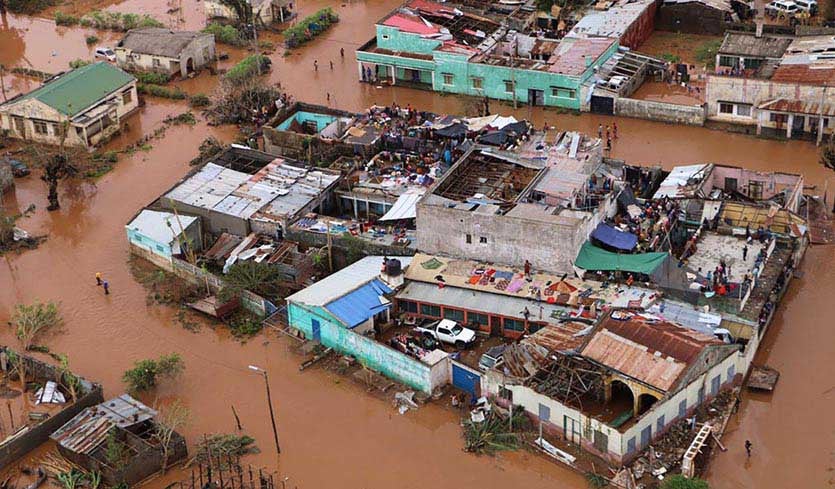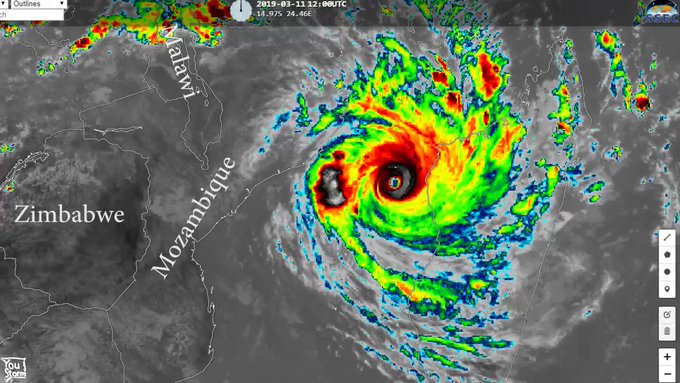March 20, 2019, 2:22 PM EDT

| Above: Residents stand on rooftops in a flooded area of Buzi (population 200,000), in central Mozambique, on March 20, 2019, after the passage of cyclone Idai. Image credit: ADRIEN BARBIER/AFP/Getty Images. |
Over 400 are dead and countless more are at grave risk, huddled on rooftops or clinging to trees, in the horrifying aftermath of Tropical Cyclone Idai in Mozambique. In scenes reminiscent of Hurricane Katrina in New Orleans in 2005, aerial survey teams photographed thousands of marooned people in the “inland ocean” up to 30 miles wide that heavy rains from Idai have created in central Mozambique.
Tropical Cyclone Idai made landfall on Thursday evening as a Category 2 storm with 110 mph winds just north of Beira, Mozambique (population 530,000) near the time of high tide, driving a devastating storm surge into the city. The cyclone also caused enormous wind damage, ripping off hundreds of roofs in Mozambique’s fourth largest city. Since the cyclone was large and moving slowly at landfall, near 6 mph, it was a prodigious rainmaker, with satellite-estimated rainfall amounts in excess of 2 feet in much of central Mozambique. Idai stalled and died over the high terrain along the Zimbabwe-Mozambique border on Saturday, but Idai’s remains hovered over the region through Tuesday, bringing additional heavy rains--over a foot in eastern Zimbabwe. Runoff from these rains have submerged huge portions of central Mozambique. Damage to improverished Mozambique, whose GDP is just $12 billion, will be many billions of dollars and take more than five years to recover from.
Over 400 deaths have been officially attributed to the storm, including the 122 deaths that occurred in northern Mozambique and southern Malawi in early March from the tropical disturbance that eventually became Idai. The subsequent landfall of Idai is being blamed for 202 deaths in Mozambique, 102 deaths in Zimbabwe, 7 in South Africa, and 3 in Madagascar. President Filipe Nyusi of Mozambique said he expects the toll to exceed 1000 in that nation, which would make it their deadliest storm on record.
Officials in Zimbabwe said they expect the death toll to reach 350 there. According to EM-DAT, this would be the deadliest flood on record for Zimbabwe, exceeding the toll of 251 in January 2017 from Tropical Cyclone Dineo.
 |
| Figure 1. Flooded areas in Mozambique (shaded black) as seen on Tuesday, March 19, 2019 by the European Space Agency (ESA) Copernicus Sentinel-1 satellite, compared to normal conditions observed from a mosaic of images obtained in early March before the flooding developed. A color-enhanced version of the image was tweeted out (below) by the ESA. Image credit: Chris Dolce, weather.com. |
The forecast: slow improvement
On Wednesday, central Mozambique got its first rays of sunshine since Idai hit on Thursday, though intermittent rain showers continued to plague the region. Rain showers will continue to affect central Mozambique through Saturday. An additional inch of rain is likely Thursday through Saturday, with isolated amounts of two inches. Beginning on Sunday, a five-day period of mostly dry weather should occur, and finally allow the region to dry out. It will take more than a week, however, for the rivers to fall below flood stage and the “inland ocean” to dry up.
 |
| Figure 2. Seven-day satellite-estimated rainfall amounts for Idai. Rainfall in excess of two feet (pink colors) fell in central Mozambique, with up to foot (red colors) in eastern Zimbabwe. This map does not show the heavy rains of over a foot that Idai’s precursor tropical disturbance dumped over northern Mozambique and southern Malawi before March 11. Image credit: NASA. |
One of the five deadliest Southern Hemisphere tropical cyclones on record
Updated as of March 29, 2019: Idai is among the deadliest Southern Hemisphere deadliest tropical cyclones on record. Using data from EM-DAT, the international disaster database, plus other official and unofficial sources, the 815 deaths officially attributed to Idai so far would make it the third deadliest Southern Hemisphere tropical cyclone on record. As is usual for catastrophic storms, there is considerable uncertainty in these numbers:
Deadliest Southern Hemisphere Tropical Cyclones
Deaths Storm Location Year
--------------------------------------------------------------------------------------------------------
--------------------------------------------------------------------------------------------------------
- 1650 Unnamed Flores, Indonesia 1973
- 1200 Unnamed Mauritius 1892
- 815 Idai Mozambique, Zimbabwe, Malawi 2019
- ~800 Eline Mozambique, Madagascar, Zimbabwe 2000
- 517 Unnamed French Polynesia 1903
- 500 Unnamed Madagascar 1951
- ~500 Unnamed Madagascar 1927
- 418 Gafilo Madagascar 2004
- 300+ Unnamed Madagascar 1959
- 300+ Mahina Australia 1899
Notes: The deadliest tropical cyclone on record for Mozambique is Eline of 2000, which hit southern Mozambique as a Category 4 storm with 130 mph winds on February 22, 2000. Eline dumped torrential rains on a region that was already suffering severe flooding from over a month of heavy rains, and the combined floods killed over 700 people in Mozambique, according to Meteo-France (thanks go to Philippe Caroff for this link). Eline also killed 12 people in Zimbabwe and 64 in Madagascar, bringing the storm’s total death toll to approximately 800. There is some uncertainty on how many of the deaths in Mozambique can be attributed to the flooding that came before Eline, though.
The January 13, 1903 cyclone that killed 517 people in Tahiti and surrounding islands is well-documented in a detailed history of tropical cyclones in the Pacific, the 2012 book Furious Winds and Parched Islands: Tropical Cyclones (1558–1970) and Drought (1722 – 1987) in the Pacific, by AnaMaria d’Aubert and Patrick D. Nunn. There are also two newspaper accounts (here and here) of the January 13, 1903 cyclone, saying that it brought a 40-foot high wave that inundated Tahiti and neighboring islands, killing as many as 5,000 – 10,000 people. However, another newspaper article mentions that a significant earthquake occurred that day as well, and the extreme wave observed during the cyclone may have been a tsunami from an earthquake. Thanks go to Jeffrey Callaghan for these links.
How to help
The International Federation of Red Cross and Red Crescent Societies, the United Nations, and Save the Childrenhave targeted donation links so you can help provide food, medical supplies, and shelter to victims of Idai in Mozambique. The United Nations says that more than 2.6 million people are in need of immediate assistance.
A spokesperson from the International Medical Corps wrote me to say that they have sent a response team to the disaster zone: “We have a longstanding presence in Zimbabwe, and our team is working to gain access to some of the most devastated areas to identify how best we can help people hurt by this destructive storm. Our experts are deploying to reach affected areas in the region to quickly expand support for health, hygiene and other needs.” Their targeted donation page for the disaster is here.
The Weather Company’s primary journalistic mission is to report on breaking weather news, the environment and the importance of science to our lives. This story does not necessarily represent the position of our parent company, IBM.







 with numerous large thunderstorms in its remnants that produced destructive floods in Mozambique
with numerous large thunderstorms in its remnants that produced destructive floods in Mozambique  and Zimbabwe
and Zimbabwe , 1 week infrared loop.
, 1 week infrared loop. 

No comments:
Post a Comment